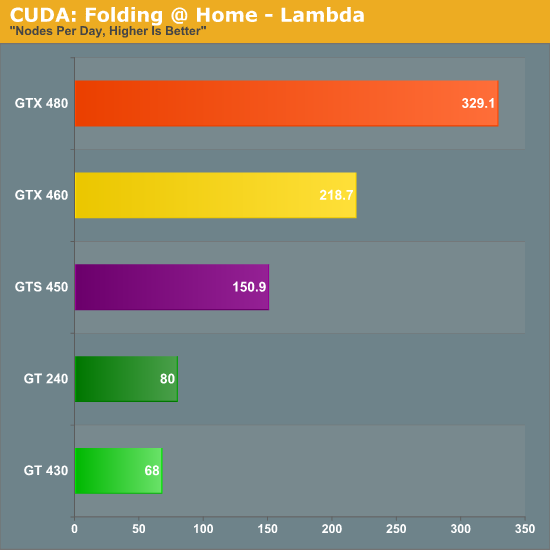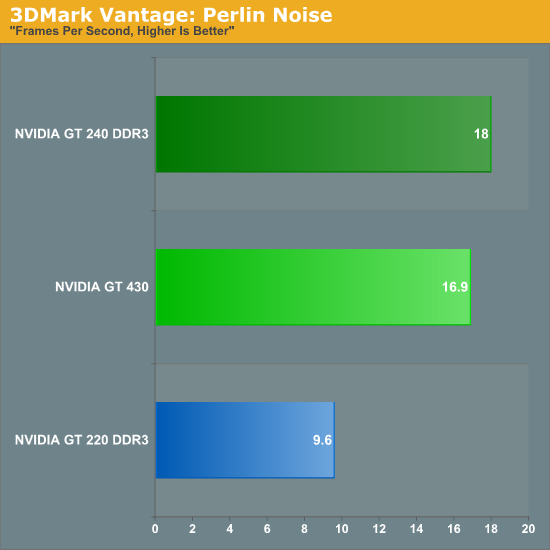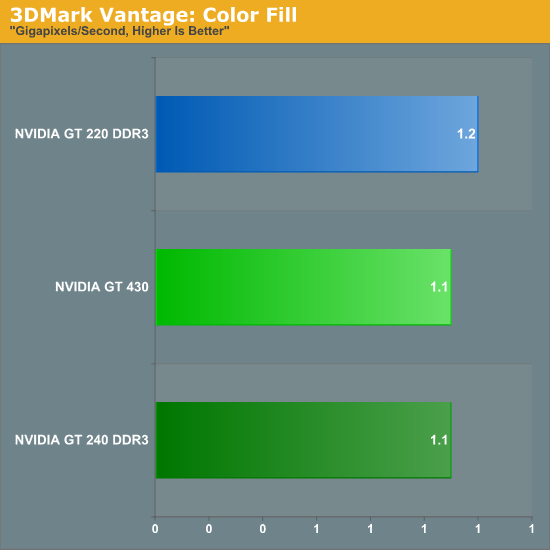NVIDIA's GeForce GT 430: The Next HTPC King?
by Ryan Smith & Ganesh T S on October 11, 2010 9:00 AM ESTCompute Performance & Synthetics
While the GT 430 isn’t meant to be a computing monster and you won’t see NVIDIA presenting it as such, it’s still a member of the Fermi family and possesses the family’s compute capabilities. This includes the Fermi cache structure, along with the 48 CUDA core SM that was introduced with GF104/GTX 460. This also means that it has a greater variation of performance than the past-generation NVIDIA cards; the need to extract ILP means the card performs between a 64 CUDA core card and a 96 CUDA core card depending on the application.
Meanwhile being based on the GF104 SM, the GT 430 is FP64 capable at 1/12th FP32 speeds (~20 GFLOPS FP64), a first for a card of this class.
For our look at compute performance we’ll turn to our trusty benchmark copy of Folding @ Home. We’ve also included the GT 240, a last-generation 96 CUDA core card just like the GT 430. This affords us an interesting opportunity to see the performance of Fermi compared to GT200 with the same number of CUDA cores in play, although GT 430 has a clockspeed advantage here that gives it a higher level of performance in theory.

The results are interesting, but also a bit distressing. GT 430’s performance as compared to the GTS 450’s performance is quite a bit lower, but this is expected. GT 240 however manages to pull ahead by nearly 17%, which is quite likely a manifestation of Fermi’s more variable performance. This makes the GT 220 comparison all the more appropriate, as if Fermi’s CUDA cores are weaker on average then GT 430 can’t hope to keep pace with GT 240.
To take a second look at CUDA core performance, we’ve also busted 3DMark Vantage out of the vault. As we’ve mentioned before we’re not huge fans of synthetic tests like 3DMark since they encourage non-useful driver optimizations for the benchmark instead of real games, but the purely synthetic tests do serve a useful purpose when trying to get to the bottom of certain performance situations.
We’ll start with the Perlin Noise test, which is supposed to be computationally bound, similar to Folding @ Home.

Once more we see the GT 430 come in behind the GT 240, even though the GT 430 has the theoretical advantage due to clockspeed. The loss isn’t nearly as great as it was under Folding @ Home, but this lends more credit to the theory that Fermi shaders are less efficient than GT21x CUDA cores. As a card for development GT 430 still has a number of advantages such as the aforementioned FP64 support and C++ support in CUDA, but if we were trying to use it as a workhorse card it looks like it wouldn’t be able to keep up with GT 240. Based on our gaming results earlier, this would seem to carry over to shader-bound games, too.
Moving on, we also used this opportunity to look at 3DMark Vantage’s color fill test, which is a ROP-bound test. With only 4 ROPs on the GT 430, this is the perfect synthetic test for seeing if having fewer ROPs really is an issue when we’re comparing GT 430 to older cards.

And the final verdict? A not very useful yes and no. GT 220 and GT 240 both have 8 ROPs, with GT 220 having the clockspeed advantage. This is why GT 220 ends up coming out ahead of GT 240 here by less than 100 MPixels/sec. But on the other hand, GT 430 has a clockspeed advantage of its own while possessing half the ROPs. The end result is that GT 430 is effectively tied with these previous-generation cards, which is actually quite a remarkable feat for having half the ROPs.
NVIDIA worked on making the Fermi ROPs more efficient and it has paid off by letting them use 4 ROPs to do what took 8 in the last generation. With this data in hand, NVIDIA’s position that 4 ROPs is enough is much more defensible, as they’re at least delivering last-generation ROP performance on a die not much larger than GT216 (GT 220). This doesn’t provide enough additional data to clarify whether the ROPs alone are the biggest culprit in the GT 430’s poor gaming performance, but it does mean that we can’t rule out less efficient shaders either.
Do note however that while Fermi ROPs are more efficient than GT21x ROPs, it’s only a saving grace when doing comparisons to past-generation architectures. GT 430 still only has ¼ the ROP power as GTS 450, which definitely hurts the card compared to its more expensive sibling.










120 Comments
View All Comments
esc923 - Monday, October 11, 2010 - link
Well you answered which means you do care, which is why I fully agree when you say that you could care less how smart anyone thinks you are.I'm not going to bother with reasoning out your obsession with video game FPS as the main 'objective' measure of an HTPC card while dismissing all else, as it's lost on you. Instead, let's try it the man no way instead: your argument is not correct because I say so.
manno - Tuesday, October 12, 2010 - link
Don't take this the wrong way, but just because someone responds to a forum post does not mean they care what anybody thinks of them.From the article:
"Whether it’s by NVIDIA’s design or matters out of their hands, GT 430 simply isn’t competitive with AMD’s 5570 and 5670 in gaming performance, with the latter cleaning the GT 430’s clock every single time. NVIDIA isn’t pushing the GT 430 as a gaming performance card so we aren’t going to recommend it as one. If you need budget gaming, then the only choice to make is to go AMD."
again for all intents and purposes the 430 and the 5570 are the same card. Same performance same price-point one is not superior to the other. Of course the 5670 is better, it's aimed at a different segment. My issue with the article isn't with you it's with "Ryan Smith & Ganesh T S" who draw the wrong conclusion. From the article:
"We always hate to rely so much on a single benchmark, but at this point HQV 2 provides the best tests we can get our hands on."
This is wrong to test image quality the best test they could use is a subjective one ie: a double blind test where they play the same clip on the two different platforms to random test subjects. Using AMD's IQ benchmarks to judge any card is inherently biased I don't care what AMD says. Just like using Nvidia's CUDA benchmarks.
The article's conclusion regarding the 430 vs 5770 is wrong for the time being do a double-blind test and revisit it. Regarding then430 vs 5770 in gaming performance conclusion, well that's just plain wrong.
ganeshts - Tuesday, October 12, 2010 - link
I am not sure where you got the idea that HQV is an AMD benchmark.HQV is an independent company and has their own video processing chip. They are not related in any way to AMD or nVidia.
manno - Tuesday, October 12, 2010 - link
My mistake and thank you for the correction.geok1ng - Tuesday, October 12, 2010 - link
well manno, that is the trollest behavior i have ever witnessed on the subject of $79 video cards.assuming you are NOT a troll, then TomsHardware and HardOCP are also wrong in the comparison with the 5570. Hardly.
Since AMDs 785G there is no need for a VGA in order to play blurays , except for 2 situations:
The very few that own a high end sound system ( $1500+) and swear that they can hear the "gap" in quality when going from 7.1 bitstreaming to lossless HD audio. These buyers do NOT pick a $79 VGA, they build a custom PC-based digital audio system to work with theirs bitperfect setup. If you dont know what bitperfect is, then dont bother trolling that the 430 is better than the 5570.
The not so very few that own a 3D TV: in 3D playback since it is lost half the resolution and/or half the brigthness image quality becomes even more important. After spending 3k+ on the TV i fail to see the reasoning on choosing the 430 over the 450, or the 460, that at least can game.
I say that HTPCs cards are a thing of the past since the 785G, HD audio is a much hyped and rarely used feature and 3D Bluray is a niche.
And the fair competitor for the 430 in 3D Bluray comes from the PS3, hence the need to compare this card image quality with the PS3, with camera pictures to silence the trolls.
8steve8 - Monday, October 11, 2010 - link
the next htpc king is sandy bridge graphics.i mean even westmere is good enough for most.
Lolimaster - Monday, October 11, 2010 - link
You mean Fusion Llano?SB is on par with the low end IGP Fusion Ontario.
8steve8 - Monday, October 11, 2010 - link
no i didn't mean llano, but any integrated graphics solution in 2011 will be fine for most people's HTPC needshmcindie - Monday, October 11, 2010 - link
I don't get the point of HQV? PowerDVD and WinDVD do all the processing themselves so the drivers shouldn't have anything to do with it.HQV also has a couple of completely ridiculous tests and hasn't been used seriously to gauge image quality in DVD's for a long while now.
hmcindie - Monday, October 11, 2010 - link
And why don't you guys tell what software you were even using? Wtf?